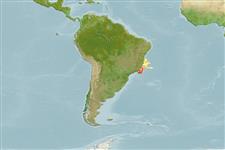Classification / Names
Common names from other countries
Main reference
Size / Weight / Age
Max length : 40.0 cm TL male/unsexed; (Ref. 1371); common length : 25.0 cm TL male/unsexed; (Ref. 6077)
Environment
Marine; demersal; non-migratory; depth range 24 - 190 m
Climate / Range
Subtropical, preferred 11°C (Ref. 107945); 21°S - 46°S, 68°W - 41°W
Distribution
Southwest Atlantic: southern Brazil, Uruguay, and northern Argentina. A new record is found in San Jorge Gulf, collected at 45°17' S, 66°54' W (Ref. 86990), extending the distribution range to southern Argentina.
Countries | FAO areas | Ecosystems | Occurrences | Introductions
Short description
Dorsal
spines
(total): 0;
Dorsal
soft rays
(total): 62-69;
Anal
spines: 0;
Anal
soft rays: 43 - 46. Body elongated; head small; eyes small. First dorsal-fin ray elongated; pelvic fins extending beyond the origin of the anal fin. Mottled pattern on back and upper sides.
IUCN Red List Status (Ref. 115185)
Threat to humans
Harmless
Human uses
Fisheries: commercial
More information
ReferencesAquacultureAquaculture profileStrainsGeneticsAllele frequenciesHeritabilityDiseasesProcessingMass conversion
Tools
Special reports
Download XML
Internet sources
Estimates of some properties based on models
Phylogenetic diversity index
PD50 = 0.5044 many relatives (e.g. carps) 0.5 - 2.0 few relatives (e.g. lungfishes)
Trophic Level
3.9 ±0.68 se; Based on food items.
Resilience
Medium, minimum population doubling time 1.4 - 4.4 years (Assuming tm=2-3)
Vulnerability
Moderate vulnerability (36 of 100)
Price category
